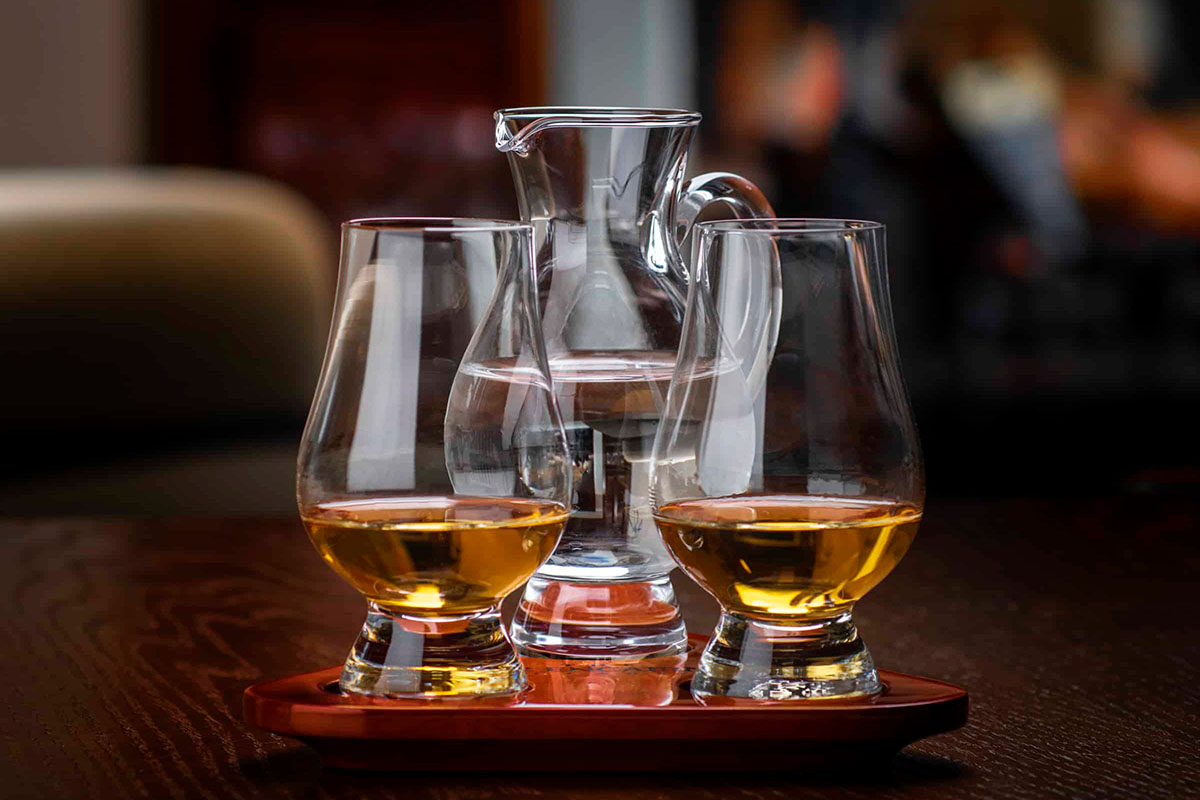The size, shape and style of the glass you drink from may not be something that you have paid much attention to in the past. But your choice can greatly alter what experience you get from a whisky and have a profound effect on the whisky that you are drinking from it. The aim should be to get the most from every whisky that you sip on.
The best option is also dependent on what you are looking for from the whisky – are you analysing it at a tutored whisky tasting or event, or simply sitting and relaxing? Maybe with a nice dram at the end of a working day or with friends? But which style to choose?
The Glencairn

The distinctively shaped Glencairn is the go-to whisky glass for many in the whisky industry and beyond. It first appeared in the early 2000s but feels like it has been around forever. It is a true market leader. The narrow, tapered opening and wider base give the perfect basis to analyse and get the most from the whisky within.
The aromas are channelled directly to the nostrils – this makes it perfect for many scenarios, especially whisky tastings. The heavy base also gives a good weight, stability and feel in the hand. The glass was designed by Raymond Davidson, the founder of Glencairn Crystal – the designers and manufacturers of high-end glassware and crystal decanters.
Davidson conceived the idea for the glass in the 1980s, but the sketch remained in a folder for the next 20 years. The inspiration came from the style of glass used by the Scotch whisky blenders – this has a narrow opening but wider base and was set on a stem with a flat base, much like the copita mentioned below.
Davidson was frustrated that whisky did not have its own definitive shape of glass as other drinks have – think Champagne flute or Cognac glass – and wanted to make something that was easily usable by consumers. The Glencairn glass has become a classic for drinking or assessing whisky and sells five million glasses worldwide per year.
The Copita

The tulip-shaped copita glass is a popular option. Like the Glencairn, the copita’s shape with a narrower opening and wider base is great for analysing and assessing a whisky. The main body of the glass sits on a thin stem – this allows you to hold it without warming the spirit.
Copitas are often used for whisky tastings as they are particularly good at showing aromas of whisky, channelling them up to your nostrils. The style of glass was adopted by the Scotch whisky industry, particularly distillers and Master Blenders, for this reason and they remain in common use
The copita glass was originally used for the sampling of sherries as they matured in oak barrels in the bodegas of southern Spain. The UK was the main export market for sherry and the copita travelled with it. The glass would be used by workers at British ports to check the quality of sherry upon arrival – from this it became known as a ‘docker’s glass’. You can buy a glass with or without a cap.
The Whisky Experience Glass

Similarly shaped to the Glencairn but with more emphasised curves, this glass can be considered a hybrid of a snifter glass. Its shape allows this glass more flexibility as it can be used to not only enjoy whisky but also other dark spirits such as rum or brandy.
This glass comes in two versions with a sturdy base (as pictured above) or with a short stem. And thanks to its wide availability and range of diverse brands producing this glass you will also find a great range of matching accessories, such as water jugs.
The Tumbler

Several other glassware options and styles are often associated with a dram of whisky. The tumbler is a popular choice, especially when relaxing and sipping. The weight and shape of a tumbler, especially when made from crystal, adds to the decadent feel of drinking and gives an air of luxury.
However, the wide opening and straight sides do not capture the aromas as well as the tulip shaped glasses do – this makes a tumbler not the best for analysing a whisky. The modern flat-bottomed tumbler, also known as a rocks glass, was developed for cocktails such as the Negroni and Old Fashioned but is great to enjoy a dram of whisky, especially if you enjoy drinking it with water or over ice.
The Quaich

Before the development of commercial glass manufacturing, the vessel of choice for consuming whisky in Scotland was the quaich – this is pronounced quake, as in earthquake. This is formed of a central bowl with handles on either side and was originally made of wood. The name is derived from the Scots Gaelic word ‘cuach’, meaning ‘cup’ or ‘drinking cup’.
Over time the wooden quaich became made of metal or pewter. Their ownership became seen as a status symbol amongst Scottish clan leaders, but their popularity was short lived. They are now largely ceremonial or ornamental. Historically, quaiches have been used as a friendship symbol. Custom dictates that if two people drink from the same quaich in turn, then they are said to be bound in friendship forever.







